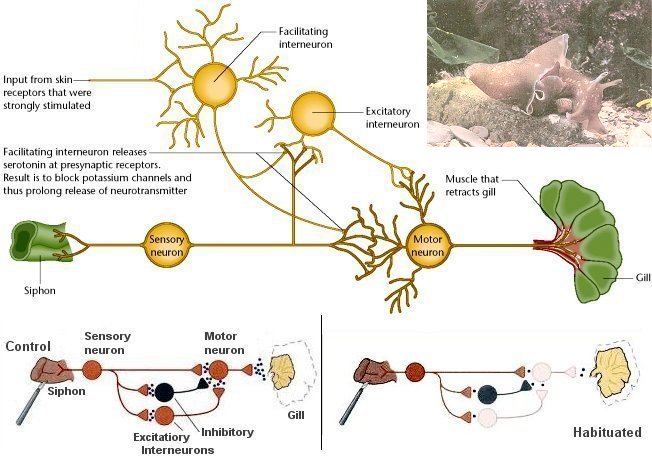Memory creation
Brain
continued from the Brain Page of Nervous System
Contents
Neurons and Nervesneurotransmitter
The Brain & Spinal Cord
Cranial Nerves
Peripheral Nervous System
Autonomic Nervous System
Senses:Eye diagrams,Hearing,Smell,Taste, Taste & Tongue Sensation,Balance
Memory , Memory types, Creation of Memory,
Higher Functions
Altered States
Memory is created by association between a group of neurons such that when one fires, they all fire, producing a specific pattern. Thought, sensory perceptions, ideas, and hallucinations - any brain function is made up of this same thing. For example, a group of neighbouring neurons firing together in the auditory cortex would bring about the experience of a certain note of music. A memory is a pattern like these. The only difference is that it remains encoded in the brain after the stimulation that originally gave rise it has ceased. Memories form when a pattern is repeated frequently, or in circumstances that encourage it to be encoded. This is because each time a group of neurons fires together the tendency to do so again is increased. Once the neighbour has been triggered to fire a chemical change takes place on its surface which leaves it more sensitive to stimulation from that same neighbour. This process is called long-term potentiation (LTP). If the neighbour cell is not stimulated again it will stay in this state of readiness for hours, maybe days. If the first cell fires again during this period, the neighbour may respond even if the firing rate of cell number one relatively slow. A second firing makes it even more receptive and so on. Eventually, repeated synchronous firing binds neurons together so that the slightest activity in one will trigger all those that have become associated with it to fire, too. A memory has been formed.
The giant sea slug called Aplysia californica¶ is often chosen for the studying of memory. Its brain has about 20000 neurons, some of which are large enough to be visible to the naked eye. Aplysia can learn and most importantly it is found that the can learn and most importantly it is found that the
 mechanisms and principles involved in its formation of short- and long-term memories are conserved throughout the animal kingdom, including in humans. slug withdraws its gill into the safety of the mantel cavity in response to a mild touch stimulus to another part of the body called the siphon (Figure 29a). If the stimulus is repeated a number of times, the gill withdrawal reflex becomes weaker until finally the animal ignores the touch stimulus. The waning of sensitivity to repeated stimulation is known as habituation and is a very simple form of learning found in all animals, including humans. Another type of learning is sensitization, when we are exposed to an unexpected or strongly unpleasant stimulus. Generally the sensitizing effect of
mechanisms and principles involved in its formation of short- and long-term memories are conserved throughout the animal kingdom, including in humans. slug withdraws its gill into the safety of the mantel cavity in response to a mild touch stimulus to another part of the body called the siphon (Figure 29a). If the stimulus is repeated a number of times, the gill withdrawal reflex becomes weaker until finally the animal ignores the touch stimulus. The waning of sensitivity to repeated stimulation is known as habituation and is a very simple form of learning found in all animals, including humans. Another type of learning is sensitization, when we are exposed to an unexpected or strongly unpleasant stimulus. Generally the sensitizing effect of Figure 29a Memory in Aplysia
[view large image]
a single alarming stimulus is short-lived, lasting perhaps for just a few minutes. But if the alarming stimulus is repeated a number of times our senses may be heightened for days and now such sensitization becomes a form of long-term memory.
- Temporal arteritis
- renal arteritis
- female strokes
- natural makeup
- Hepatitis
- Noise in artery
- breast
- Cbreast chemicals
- mammogram
- strokes
- Bra
- urine
- Bhudda
- Calcium
- D Vitamin
- Amyloid
- spinal nerves
- Green tea
- Day break
- Homeopathy
- renal failure
- Cholestrol
- Vasculitis
- Clay baths
- Steaming Sand Baths
- Coconut oil Benefits
- Deodorants cancer
- Toxic Lipstick
- Niacin deficiency
- Vitamin -D
- Vitamin-C
- Vitamin-E
- Spiritual illness
- Names of Allah
- ACV
- Healthy Oils
- Feet Home
- Beauty Tips for Women
- Celiac disease
- Right Fat Diet
- Apple juice
- Vinegar Benefits
- Supplements
- Cupping
- Alzheimers
- CMT neuropathy